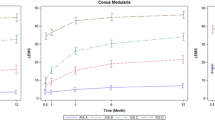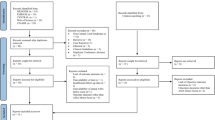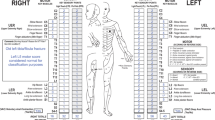Abstract
Introduction
The neurological examination terminologies and definitions of the status of spinal cord injured (SCI) patients are of great importance to establish scales and provide standard nomenclatures. There is a disagreement between the classical neurological terminology and the definitions of complete and incomplete paraplegia that have been proposed in traumatic spinal cord injured patients.
Objective
To discuss the adequacy and the impact of the terms incomplete paraplegia and paraparesis in current literature.
Materials and methods
A review of the origin of the terms, definitions and nomenclatures applied by the most widespread assessment scales in traumatic SCI published in peer review papers was performed, searching the scales cited on the references of the latest American Spinal Injury Association classification (2002; available in http://www.asia-spinalinjury.org/) up to the first classification, described by Frankel et al. [14].
Results
The term “incomplete paraplegia” has been used to define clinical situations classically described as “paraparesis”.
Conclusion
The terms “complete” and “incomplete” are adequately used to characterize the completeness of spinal cord lesion but inadequately used when associated to the term “plegia” as a qualifier. Therefore, patients with any preservation of motor strength below the injury level should be described as paraparetic and not as incomplete paraplegic.
Similar content being viewed by others
References
American Spinal Injury Association (ASIA) (1984) Ninth annual scientific meeting. April 11th-13th,1983, Denver, Colorado, U.S.A. Abstracts. Paraplegia 22(1):45–54
Aouad R, Badaro H (1966) Unstable fracture-dislocation of the lumbar spine with incomplete paraplegia [in French]. Rev Med Moyen Orient 23:216–217
Ayala L, Barber DB, Lomba MR, Able AC (2000) Intramedullary sarcoidosis presenting as incomplete paraplegia: case report and literature review. J Spinal Cord Med 23:96–99
Band D (1956) Lesions of the bladder in incomplete paraplegia. Br J Urol 28:37–52
Bracken MB, Collins WF, Freeman DF, Shepard MJ, Wagner FW, Silten RM, Hellenbrand KG, Ransohoff J, Hunt WE, Perot PL Jr (1984) Efficacy of methylprednisolone in acute spinal cord injury. JAMA 251:45–52
Bracken MB, Shepard MJ, Collins WF, Holford TR, Young W, Baskin DS et al (1992) Methylprednisolone or naloxone treatment after acute spinal-cord injury: 1-year follow-up data. Results of the second national acute spinal cord injury study. J Neurosurg 76:23–31
Bracken MB, Webb SB Jr, Wagner FC (1978) Classification of the severity of acute spinal cord injury: Implications for management. Paraplegia 15:319–326
Broglio R (1951) Cases of spastic paraparesis treated by resection of the sympathetic nerve; results after 16 years. Acta Chir Patav 7:578
Cohen ME, Ditunno JF Jr, Donovan WH, Maynard FM Jr (1998) A test of the 1992 International Standards for Neurological and Functional Classification of Spinal Cord Injury. Spinal Cord 36:554–560
DeJong RN (1992) Disorders of the spinal cord, in DeJong RN DeJong’s. The Neurologic Examination, 5th edn Philadelphia, Lippincott Williams e Wilkings, pp 585–586
DeJong RN (1992) Motor strength and power, in DeJong RN DeJong’s. The Neurologic Examination, 5th edn Philadelphia, Lippincott Williams e Wilkings, pp 335–339
Ditunno JF Jr, Young W, Donovan WH, Creasey G (1994) The International Standards Booklet of Neurological and Functional Classification of Spinal Cord Injury. Paraplegia 32:70–80
Duus P (2005) Motor system. In: Duus P (ed) Duus’ topical diagnosis in neurology. Anatomy. Physiology. Signs. Symptoms. 4th edn. Stuttgart, Thieme, pp 55–114
Frankel HL, Hancock DO, Hyslop G, Melzak J, Michaelis LS, Ungar GH, Vernon JD, Walsh JJ (1969) The value of postural reduction in the initial management of closed injuries of the spine with paraplegia and tetraplegia. Paraplegia 7:179–192
Hadley MN, Walters BC, Grabb PA, Oyesiku NM, Przybylski GJ, Resnick DK, Ryken TC (2002) Clinical Assessment after acute cervical spinal cord injury. Neurosurgery 50:21–29
Kasai Y, Shi D, Sugimoto T, Takegami K, Uchida A (2005) Outcome of late surgical treatment in patients with incomplete paraplegia due to spinal degenerative diseases. Spinal Cord 43:171–174
Kedlaya D, Brandstater ME, Lee JK (1998) Immobilisation hypercalcaemia in incomplete paraplegia: successful treatment with pamidronate. Arch Phys Med Rehabil 79:222–225
Konishi N, Shimada Y, Sato K, Kagaya H, Sato M (1998) Electrophysiologic evaluation of denervated muscles in incomplete paraplegia using macro electromyography. Arch Phys Med Rehabil 79:1062–1068
Konishi N, Shimada Y, Sato K, Kagaya H, Sato M (1998) Electrophysiologic evaluation of denervated muscles in incomplete paraplegia using macro electromyography. Arch Phys Med Rehabil 79:1062–1068
Krengel WF 3rd, Anderson PA, Henley MB (1993) Early stabilisation and decompression for incomplete paraplegia due to a thoracic-level spinal cord injury. Spine 18:2080–2087
Lucas JR, Ducker TB (1979) Motor classification of spinal cord injuries with mobility, morbidity and recovery indices. The American Surgeon 151–158
Michaelis LS, Braakman R (1976) Current terminology and classification of injuries of spine and spinal cord. In: Vinken PJ, Bruyn GW (eds) Handbook of clinical neurology. American Elsevier Publishing Co., vol 25. pp 145–153
Michaelis LS (1969) International inquiry on neurological terminology and prognosis in paraplegia and tetraplegia. Paraplegia 7:1–5
Resnick DK, Oyesiku NM (2005) What is the best way to assess and classify spinal cord-injured patients? In: Valadka AB, Andrews BT (eds) Neurotrauma: evidence-based answers to common questions, 1st edn. Thieme, pp 15–18
Seymour RJ, Bassler CR (1977) Electromyographic biofeedback in the treatment of incomplete paraplegia. Phys Ther 57:1148–1150
Stauffer S (1975) Diagnosis and prognosis of acute cervical spinal cord injury. Clin Ortho Rel 112:9–15
Waters RL, Adkins RH, Yakura JS, Sie I (1993) Motor and sensory recovery following complete paraplegia. Arch Phys Med Rehabil 74:242–247
Waters RL, Adkins RH, Yakura JS, Sie I (1994) Motor and sensory recovery following incomplete paraplegia. Arch Phys Med Rehabil 75:67–72
Waters RL, Adkins RH, Yakura JS, Sie I (1994) Motor and sensory recovery following incomplete tetraplegia. Arch Phys Med Rehabil 75:306–311
Waters RL, Yakura JS, Adkins RH, Sie I (1992) Recovery following complete paraplegia. Arch Phys Med Rehabil 73:784–789
Wernig A, Nanassy A, Müller S (1999) Laufband: (treadmill) therapy in incomplete paraplegia and tetraplegia. J Neurotrauma 16:719–726
Zhu WX, Liu XY, He ZJ, Mo XF, Zhou XM, Guo JE (2005) Therapeutic effects of antero-lateral decompression and fixation on thoraco-lumbar fractures complicated with incomplete paraplegia [in Chinese]. Di Yi Jun Yi Da Xue Xue Bao 25:1540–1542
Author information
Authors and Affiliations
Corresponding author
Rights and permissions
About this article
Cite this article
Evangelista Santos Barcelos, A.C., Scardino, F.B., Patriota, G.C. et al. Paraparesis or incomplete paraplegia? How should we call it?. Acta Neurochir 151, 369–372 (2009). https://doi.org/10.1007/s00701-009-0238-0
Received:
Accepted:
Published:
Issue Date:
DOI: https://doi.org/10.1007/s00701-009-0238-0




